Guenon
The guenons (/ɡəˈnoʊn/ or /ˈɡwɛnən/) are the genus Cercopithecus of Old World monkeys. Not all members of this genus have the word "guenon" in their common names; also, because of changes in scientific classification, some monkeys in other genera may have common names that include the word "guenon". Nonetheless, the use of the term guenon for monkeys of this genus is widely accepted.
| Guenons[1] | |
|---|---|
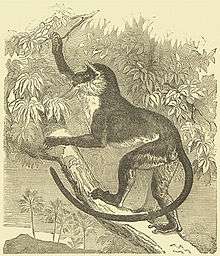 | |
| Roloway monkey Darwin's "Descent of man" (1872) | |
| Scientific classification | |
| Kingdom: | Animalia |
| Phylum: | Chordata |
| Class: | Mammalia |
| Order: | Primates |
| Suborder: | Haplorhini |
| Infraorder: | Simiiformes |
| Family: | Cercopithecidae |
| Subfamily: | Cercopithecinae |
| Tribe: | Cercopithecini |
| Genus: | Cercopithecus Linnaeus, 1758 |
| Type species | |
| Simia diana | |
| Species | |
|
See text | |
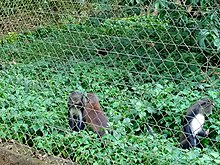
All members of the genus are endemic to sub-Saharan Africa, and most are forest monkeys. Many of the species are quite local in their ranges, and some have even more local subspecies. Many are threatened or endangered because of habitat loss. The species currently placed in the genus Chlorocebus, such as vervet monkeys and green monkeys, were formerly considered as a single species in this genus, Cercopithecus aethiops.
In the English language, the word "guenon" is apparently of French origin.[2] In French, guenon was the common name for all species and individuals, both males and females, from the genus Cercopithecus. In all other monkey and apes species, the French word guenon only designates the females.[3]
Species list
Genus Cercopithecus
- C. dryas group
- Dryas monkey or Salongo monkey, Cercopithecus dryas
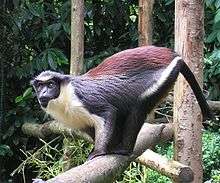
- C. diana group
- Diana monkey, Cercopithecus diana
- Roloway monkey, Cercopithecus roloway
- C. mitis group
- Greater spot-nosed monkey, Cercopithecus nictitans
- Cercopithecus nictitans nictitans
- Bioko putty-nosed guenon, Cercopithecus nictitans martini
- Blue monkey, Cercopithecus mitis
- Pluto monkey, Cercopithecus mitis mitis
- Silver monkey, Cercopithecus doggetti
- Golden monkey, Cercopithecus kandti
- Sykes' monkey, Cercopithecus albogularis
- Zanzibar Sykes' monkey, Cercopithecus albogularis albogularis
- Pousargues' Sykes' monkey, Cercopithecus albogularis albotorquatus
- Cercopithecus albogularis erythrarchus
- Cercopithecus albogularis francescae
- Cercopithecus albogularis kibonotensis
- Cercopithecus albogularis kolbi
- White-lipped monkey, Cercopithecus albogularis labiatus
- Cercopithecus albogularis moloneyi
- Cercopithecus albogularis monoides
- Cercopithecus albogularis phylax
- Cercopithecus albogularis schwarzi
- Zammarano's white-throated guenon, Cercopithecus albogularis zammaranoi
- Greater spot-nosed monkey, Cercopithecus nictitans
- C. mona group
- Mona monkey, Cercopithecus mona
- Campbell's mona monkey, Cercopithecus campbelli
- Lowe's mona monkey, Cercopithecus lowei
- Crested mona monkey, Cercopithecus pogonias
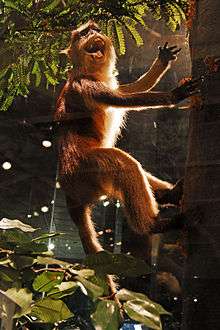 Crested mona monkey (C. pogonias)
Crested mona monkey (C. pogonias)- Cercopithecus pogonias pogonias
- Cercopithecus pogonias nigripes
- Cercopithecus pogonias grayi
- Cercopithecus pogonias schwarzianus
- Wolf's mona monkey, Cercopithecus wolfi
- Cercopithecus wolfi wolfi
- Cercopithecus wolfi elegans
- Dent's mona monkey, Cercopithecus denti
- C. cephus group
- Lesser spot-nosed monkey, Cercopithecus petaurista
- Cercopithecus petaurista petaurista
- Cercopithecus petaurista buettikoferi
- White-throated guenon, Cercopithecus erythrogaster
- Red-eared guenon, Cercopithecus erythrotis
- Bioko red-eared guenon, Cercopithecus erythrotis erythrotis
- Cercopithecus erythrotis camerunensis
- Moustached guenon, Cercopithecus cephus
- Cercopithecus cephus cephus
- Cercopithecus cephus cephodes
- Ngotto guenon, Cercopithecus cephus ngottoensis
- Red-tailed monkey, Cercopithecus ascanius
- Cercopithecus ascanius ascanius
- Cercopithecus ascanius atrinasus
- Cercopithecus ascanius whitesidei
- Cercopithecus ascanius katangae
- Schmidt's guenon, Cercopithecus ascanius schmidti
- Sclater's guenon, Cercopithecus sclateri
- Lesser spot-nosed monkey, Cercopithecus petaurista
- C. lhoesti group
- L'Hoest's monkey, Cercopithecus lhoesti
- Preuss's monkey, Cercopithecus preussi
- Sun-tailed monkey, Cercopithecus solatus
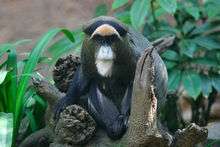
- C. hamlyni group
- Hamlyn's monkey, Cercopithecus hamlyni
- Owl-faced guenon, Cercopithecus hamlyni hamlyni
- Kahuzi owl-faced guenon, Cercopithecus hamlyni kahuziensis
- Lesula, Cercopithecus lomamiensis
- Hamlyn's monkey, Cercopithecus hamlyni
- C. neglectus group
- De Brazza's monkey, Cercopithecus neglectus
Hybrids
The red-tailed monkey (Cercopithecus ascanius) is known to hybridize with the blue monkey (C. mitis) in several locations in the wild in Africa.[4]
References
- Groves, C. P. (2005). "GENUS Cercopithecus". In Wilson, D. E.; Reeder, D. M (eds.). Mammal Species of the World: A Taxonomic and Geographic Reference (3rd ed.). Johns Hopkins University Press. pp. 154–158. ISBN 978-0-8018-8221-0. OCLC 62265494.
- guenon /gəˈnoʊn/ n. M19. [Fr., of uncertain origin.] (The New Shorter Oxford English Dictionary, Clarendon Press, Oxford, Vol. 1 A-M, 1993 edition, see page 1,157)
- guenon [gənɔ̃] n. f. - 1505 ; o. i. ; p.-ê même rad. que guenille 1. vx Cercopithèque, mâle ou femelle. 2. MOD. Singe femelle. [...] (Le Petit Robert, grand format, Dictionnaires Le Robert, Paris, first edition: 1967, Nouveau Petit Robert edition: 1993, grand format edition: 1996, ISBN 2-85036-469-X, see page 1,056)
- Rowe, N. (1996). The Pictorial Guide to the Living Primates. Pogonias Press. pp. 139, 143, 154, 185, 223. ISBN 0-9648825-0-7.
External links
| Wikispecies has information related to Guenon |

- Primate Info Net Cercopithecus Factsheets